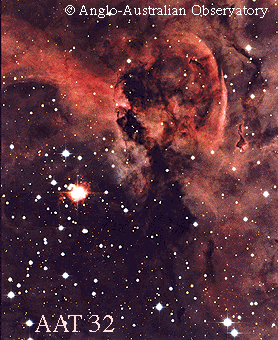Astronomy Picture of the Day
Discover the cosmos!
Each day a different image or photograph of our fascinating universe is
featured, along with a brief explanation written by a professional
astronomer.
April 4, 1996

The Keyhole Nebula Near Eta Carinae
Credit:
Anglo-Australian Telescope
photograph by David Malin
Copyright:
Anglo-Australian Telescope
Board
Explanation:
The dark dusty Keyhole Nebula gets its name from its unusual shape.
Designated NGC 3324, the
Keyhole
Nebula is a smaller region superposed on the bright
Eta Carina
Nebula.
The Eta Carina Nebula is the largest nebula in angular extent on the sky,
larger than the famous Orion Nebula,
but its southerly location makes it less familiar to Northern Hemisphere
skywatchers.
The star Eta Carinae
itself is extremely variable and has faded in a mere 150 years - formerly
one of the brightest in the sky it is now invisible
without a telescope.
The nebula created by the star's
19th century outburst has been photographed by the
Hubble Space Telescope.
Tomorrow's picture: The Perseus Cluster of Galaxies
<
Archive
| Index
| Search
| Calendar
| Glossary
| Education
| About APOD
>
Authors & editors:
Robert Nemiroff
(MTU) &
Jerry
Bonnell (USRA)
NASA Technical Rep.:
Jay Norris.
Specific rights apply.
A service of:
LHEA
at
NASA/
GSFC
&:
Michigan Tech. U.
